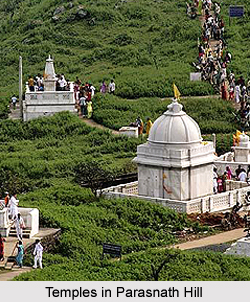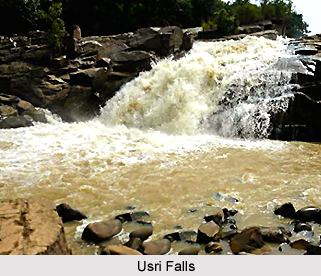 Giridih District, an administrative district of Jharkhand has its headquarters at Giridih. Giridih District was carved out from Hazaribagh District on 4th December, 1972. The district lies between 24 degree 11 minutes north latitude and 86 degree 18 minutes east longitude. Lying almost in the central part of the North Chota Nagpur Plateau Division, this district is bounded by Jamui District and part of Nawada district of Bihar in the north, by the districts of Deoghar and Jamtara on the east, by Dhanbad District and Bokaro District on the south and west by districts of Hazaribagh and Kodarma. Giridih District is spread over an area of 4853.56 sq km. The famous Parasnath hill is situated here and it is the highest peak of Jharkhand having altitude of 4431 feet above the sea-level. The district is also famous as a place of ruby mica and coal field. The famous Grand Trunk Road also passes through this district.
Giridih District, an administrative district of Jharkhand has its headquarters at Giridih. Giridih District was carved out from Hazaribagh District on 4th December, 1972. The district lies between 24 degree 11 minutes north latitude and 86 degree 18 minutes east longitude. Lying almost in the central part of the North Chota Nagpur Plateau Division, this district is bounded by Jamui District and part of Nawada district of Bihar in the north, by the districts of Deoghar and Jamtara on the east, by Dhanbad District and Bokaro District on the south and west by districts of Hazaribagh and Kodarma. Giridih District is spread over an area of 4853.56 sq km. The famous Parasnath hill is situated here and it is the highest peak of Jharkhand having altitude of 4431 feet above the sea-level. The district is also famous as a place of ruby mica and coal field. The famous Grand Trunk Road also passes through this district.
History of Giridih District
History of Giridih District is a part of the history of its parent district, Hazaribagh as well as also of the Chota Nagpur Plateau. The entire territory of Chota Nagpur, known as Jharkhand was believed to be covered with inaccessible hills and forests. Though this region was in touch with many parts of India, yet the non-Aryan tribes who resided here had no king. The inhabitant of Chota Nagpur decided to elect a king due to regular foreign invaders and Mundas became the king of the state. As per the history of Giridih District, Chota Nagpur division including the district of Giridih appears to have remained unexploited. The succession of Akbar to the throne of Delhi in 1556 AD opens a new chapter in the history of Jharkhand. To the Mughal Emperors it was also known as Kukrah. During that period, the region was first introduced as revenue administration of Mughal. The conquered provinces as they were then called were formed into a British district which comprised Ramgarh, Kendi, Kunda and Kharagdiha (which together constituted the old district of Hazaribagh comprising Giridih) and the whole of Palamu. Subsequent to the Kol rising in 1931 which, however, did not seriously affect Giridih, the administrative structure of the territory was, however, changed.
These provinces became part of the Southwest Frontier Agency and were formed into a division named Hazaribagh, with Hazaribagh as the administrative headquarters. In 1854 the designation of the south-west Frontier Agency was changed to Chota Nagpur and it began to be administered as a Non-regulation Province under the Lieutenant Governor of Bihar.
 Geography of Giridih District
Geography of Giridih District
Geographically, Giridih District is broadly divided into two natural divisions, namely the central plateau and lower plateau. The central plateau touches the western portion of the district near Bagodar block. The lower plateaus have an average height of 1300 feet, their surface being undulating. In the north and north-west, the lower plateaus form fairly level tablelands until they reach the ghats when they drop to about 700 feet. The district comprises vast forests which are uniformly distributed. Sal is the most famous and predominant species of trees found here. Among other common species are bamboo, simul, mahua, palas, kusum, kend, asan piar and bhelwa. Giridih District is divided into two main water heads - Barakar and Sakri rivers. The district is rich in mineral resources and it has several large coal fields which contain one of the best qualities of metallurgical coal in India. Mica is found extensively in this district, which is of importance not only to Jharkhand but to India and other countries also. It is mostly found near the blocks Tisri and Gawan.
Demography of Giridih District
According to the Population Census in the year 2011, Giridih District had population of 2,445,203 of which male and female were 1,258,607 and 1,186,596 respectively. Giridih District population constituted 7.42 percent of total population of Jharkhand. In 2001 census, this figure for Giridih District was at 7.07 percent of Maharashtra population. There was change of 28.33 percent in the population compared to population as per 2001. In the previous census of India 2001, Giridih District recorded increase of 27.28 percent to its population compared to 1991. The average literacy rate of Giridih in 2011 was 65.12 percent compared to 44.50 of 2001. If things are looked out at gender wise, the male and female literacy rates were 79.08 percent and 50.33 percent respectively. The total literates in Giridih District were 1,298,933 of which male and female were 811,110 and 487,694 respectively. With regards to Sex Ratio in Giridih District, it stood at 943 per 1000 male. The average national sex ratio in India is 940. In 2011 Population census, the child sex ratio is 934 girls per 1000 boys compared to figure of 978 girls per 1000 boys of 2001 census data.
Tourism in Giridih District
There are several popular tourist attractions in Giridih District. The sightseeing options offered by the district are simply worth visiting. The travellers visiting this district can also have an adventurous experience with the options available. The important tourist attractions of Giridih District are Usri Fall, Khandoli, Madhuban, Parasnath Hills, Jharkhandi Dham and Harihar Dham.






